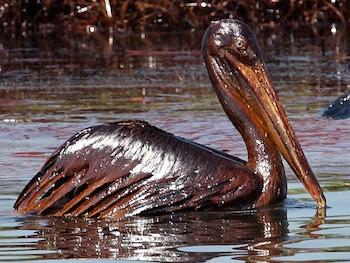Less than a week after Politico allowed BP communications vice president Geoff Morrell the space to tell Americans that there are no lingering effects from the BP oil spill in the Gulf of Mexico, scientists and researchers have brought in new evidence to show that Morrell’s claims are completely fabricated.
According to the peer-reviewed Proceedings of the National Academy of Science, millions of gallons of BP from the 2010 Macondo well blowout have settled along the floor of the Gulf of Mexico, creating a “bathtub ring” of oil around the site of the blowout.
How much oil are they talking about? Think Progress reports that about 10 million gallons of coagulated crude sits on the Gulf floor, blanketing an area of more than 1,235 square miles. To put that into perspective, Think Progress says that the oil on the floor is enough to completely cover the city of Houston, Texas, or the entire state of Rhode Island.
BP was quick to deny the claims, saying that the scientists should examine the chemical properties of the oil and verify that it did, indeed, come from the Macondo well. Every oil well carries its own unique “chemical signature,” which is how researchers have been able to match tar balls and other forms of oil that have washed ashore back to BP’s Macondo well.
This “bathtub ring” of coagulated crude is BP’s footprint in the Gulf of Mexico, and it is a lingering reminder of the damage that they caused to a once-thriving ecosystem. The fact that millions of barrels worth of oil are still sitting on the ocean floor represents an immeasurable threat to wildlife, as well as to the Gulf Coast economy.
Even more than being a reminder, the “bathtub ring” serves as evidence that BP is doing everything in their power to cover up the dangers of their negligence. In his Politico op-ed, Morrell told us that the unrecovered oil would settle at the bottom of the Gulf, where oil-eating microbes and bacteria would then consume it.
While that is something that happens in nature, researchers say that the amount of oil that BP released into the Gulf was far too much for the microbes to digest, which helps explain why so much is still left on the seafloor.
To complicate matters, the bathtub ring of oil is also laden with toxic dispersants.
Corexit, BP’s dispersant of choice, was sprayed by the barrel full into the Gulf following the blowout. The job of the dispersant is to help the oil break apart and to eliminate the surface tension by binding with the oil.
The chemical process is complicated, but the overall effect is to have the dispersant cling to oil on the surface, change its chemical properties, and sink it to the bottom. And that is exactly what has happened.
Earlier this week, Politico ran an op-ed from Kara Lankford, the interim director of the Gulf Restoration Program at Ocean Conservancy, where she refuted the claims made by Morrell and BP.
Perhaps the publication was feeling the heat from the countless articles pointing out their fluff piece on the spill, or perhaps they got their hands on an advanced copy of the “bathtub ring” report.
Either way, there’s no denying any more that the effects of BP’s Gulf of Mexico oil spill are still being felt, and many believe that we haven’t even seen the worst of it yet.
Subscribe to our newsletter
Stay up to date with DeSmog news and alerts






